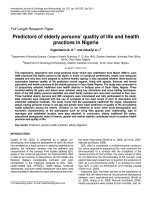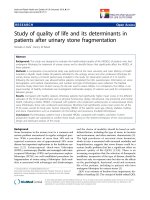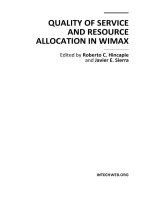Quality of Service and Resource Allocation in WiMAXFig Part 1 pdf
Bạn đang xem bản rút gọn của tài liệu. Xem và tải ngay bản đầy đủ của tài liệu tại đây (756.82 KB, 25 trang )
QUALITY OF SERVICE
AND RESOURCE
ALLOCATION IN WIMAX
Edited by Roberto C. Hincapie
and Javier E. Sierra
Quality of Service and Resource Allocation in WiMAX
Edited by Roberto C. Hincapie and Javier E. Sierra
Published by InTech
Janeza Trdine 9, 51000 Rijeka, Croatia
Copyright © 2012 InTech
All chapters are Open Access distributed under the Creative Commons Attribution 3.0
license, which allows users to download, copy and build upon published articles even for
commercial purposes, as long as the author and publisher are properly credited, which
ensures maximum dissemination and a wider impact of our publications. After this work
has been published by InTech, authors have the right to republish it, in whole or part, in
any publication of which they are the author, and to make other personal use of the
work. Any republication, referencing or personal use of the work must explicitly identify
the original source.
As for readers, this license allows users to download, copy and build upon published
chapters even for commercial purposes, as long as the author and publisher are properly
credited, which ensures maximum dissemination and a wider impact of our publications.
Notice
Statements and opinions expressed in the chapters are these of the individual contributors
and not necessarily those of the editors or publisher. No responsibility is accepted for the
accuracy of information contained in the published chapters. The publisher assumes no
responsibility for any damage or injury to persons or property arising out of the use of any
materials, instructions, methods or ideas contained in the book.
Publishing Process Manager Tajana Jevtic
Technical Editor Teodora Smiljanic
Cover Designer InTech Design Team
First published January, 2012
Printed in Croatia
A free online edition of this book is available at www.intechopen.com
Additional hard copies can be obtained from
Quality of Service and Resource Allocation in WiMAX,
Edited by Roberto C. Hincapie and Javier E. Sierra
p. cm.
978-953-307-956-1
Contents
Preface IX
Part 1 Scheduling and Resource Allocation Algorithms 1
Chapter 1 Scheduling Mechanisms 3
Márcio Andrey Teixeira and Paulo Roberto Guardieiro
Chapter 2 A Comprehensive Survey on
WiMAX Scheduling Approaches 25
Lamia Chaari, Ahlem Saddoud,
Rihab Maaloul and Lotfi Kamoun
Chapter 3 Scheduling Mechanisms with
Call Admission Control (CAC) and an
Approach with Guaranteed Maximum
Delay for Fixed WiMAX Networks 59
Eden Ricardo Dosciatti,
Walter Godoy Junior and Augusto Foronda
Chapter 4 Scheduling Algorithm and
Bandwidth Allocation in WiMAX 85
Majid Taghipoor, Saeid MJafari and Vahid Hosseini
Chapter 5 Downlink Resource
Allocation and Frequency
Reuse Schemes for WiMAX Networks 105
Nassar Ksairi
Chapter 6 Multi Radio Resource Management
over WiMAX-WiFi Heterogeneous Networks:
Performance Investigation 129
Alessandro Bazzi and Gianni Pasolini
Chapter 7 A Cross-Layer Radio Resource
Management in WiMAX Systems 147
Sondes Khemiri Guy Pujolle
and Khaled Boussetta Nadjib Achir
VI Contents
Part 2 Quality of Service Models and Evaluation 175
Chapter 8 A Unified Performance Model
for Best-Effort Services in WiMAX Networks 177
Jianqing Liu, Sammy Chan and Hai L. Vu
Chapter 9 A Mobile WiMAX Architecture with QoE
Support for Future Multimedia Networks 193
José Jailton, Tássio Carvalho, Warley Valente, Renato Frânces,
Antônio Abelém, Eduardo Cerqueira and Kelvin Dias
Chapter 10 Evaluation of QoS and QoE in
Mobile WIMAX – Systematic Approach 217
Adam Flizikowski, Marcin Przybyszewski,
Mateusz Majewski and Witold Hołubowicz
Part 3 WiMAX Applications and Multi-Hop Architectures 243
Chapter 11 Efficient Video Distribution over
WiMAX-Enabled Networks for
Healthcare and Video Surveillance Applications 245
Dmitry V. Tsitserov and Dmitry K. Zvikhachevsky
Chapter 12 Cross-Layer Application of Video
Streaming for WiMAX: Adaptive
Protection with Rateless Channel Coding 273
L. Al-Jobouri and M. Fleury
Chapter 13 Public Safety Applications
over WiMAX Ad-Hoc Networks 291
Jun Huang, Botao Zhu and Funmiayo Lawal
Chapter 14 Multihop Relay-Enhanced WiMAX Networks 319
Yongchul Kim and Mihail L. Sichitiu
Chapter 15 Cost Effective Coverage
Extension in IEEE802.16j
Based Mobile WiMAX Systems 341
Se-Jin Kim, Byung-Bog Lee, Seung-Wan Ryu,
Hyong-Woo Lee and Choong-Ho Cho
Chapter 16 A WiMAX Network
Architecture Based on Multi-Hop Relays 359
Konstantinos Voudouris, Panagiotis Tsiakas,
Nikos Athanasopoulos, Iraklis Georgas,
Nikolaos Zotos and Charalampos Stergiopoulos
Preface
This book has been prepared to present state of the art on WiMAX Technology. It has
been constructed with the support of many researchers around the world, working on
resource allocation, quality of service and WiMAX applications. Such many different
works on WiMAX, show the great worldwide importance of WiMAX as a wireless
broadband access technology.
This book is intended for readers interested in resource allocation and quality of
service in wireless environments, which is known to be a complex problem. All
chapters include both theoretical and technical information, which provides an in
depth review of the most recent advances in the field for engineers and researchers,
and other readers interested in WiMAX.
In the first section, readers will find chapters on resource allocation techniques, such as
scheduling, call admission control, frequency reuse and cross-layer techniques. The
second section presents the evaluation of various models for ensuring the QoS for
applications running on WiMAX networks. Finally in the third section, applications
for WiMAX are presented, with wireless mesh networks based on multi-hop and relay
architectures.
Roberto C. Hincapie, PhD & Javier E. Sierra, PhD
Universidad Pontificia Bolivariana, Medellín,
Colombia
Part 1
Scheduling and Resource
Allocation Algorithms
1
Scheduling Mechanisms
Márcio Andrey Teixeira
and Paulo Roberto Guardieiro
1
Federal Institute of Education, Science and Technology of São Paulo,
2
Faculty of Electrical Engineering, Federal University of Uberlândia,
Brazil
1. Introduction
The WiMAX technology, based on the IEEE 802.16 standards (IEEE, 2004) (IEEE, 2005), is a
solution for fixed and mobile broadband wireless access networks, aiming at providing
support to a wide variety of multimedia applications, including real-time and non-real-time
applications. As a broadband wireless technology, WiMAX has been developed with
advantages such as high transmission rate and predefined Quality of Service (QoS)
framework, enabling efficient and scalable networks for data, video, and voice. However,
the standard does not define the scheduling algorithm which guarantees the QoS required
by the multimedia applications. The scheduling is the main component of the MAC layer
that helps assure QoS to various applications (Bacioccola, 2010). The radio resources have to
be scheduled according to the QoS parameters of the applications. Therefore, the choice of
the scheduling algorithm for the WiMAX systems is very important. There are several
scheduling algorithms for WiMAX in the literature, however, studies show that an efficient,
fair and robust scheduling algorithm for WiMAX systems is still an open research area (So-
in et al., 2010) (Dhrona et al., 2009) (Cheng et al., 2010).
The packets that cross the MAC layer are classified and associated with a service class. The
IEEE 802.16 standards define five service classes: Unsolicited Grant Service (UGS), extended
real-time Polling Service (ertPS), real-time Polling Service (rtPS), non real-time Polling
Service (nrtPS) and Best Effort (BE). Each service class has different QoS requirements and
must be treated differently by the Base Station. The scheduling algorithm must guarantee
the QoS for both multimedia applications (real-time and non-real-time), whereas efficiently
utilizing the available bandwidth.
The rest of the chapter is organized as follows. Section 2 presents the features of the WiMAX
MAC layer and of the WiMAX scheduling classes. The main components of the MAC layer
are presented. Then, the key issues and challenges existing in the development of
scheduling mechanisms are shown, making a link between the scheduling algorithm and its
implementation. Section 3 provides a comprehensive classification of the scheduling
mechanisms. Then, the scheduling mechanisms are compared in accordance with the QoS
requirement guarantee. Section 4 describes the scheduling algorithms found in the literature
in accordance with the classification of the scheduling mechanisms provided in the Section
Quality of Service and Resource Allocation in WiMAX
4
3. Then, the performance evaluation of these algorithms is made. Section 5 presents a
synthesis table of the main scheduling mechanisms and highlights the main points of each
of them. Section 6 does the final consideration of this chapter.
2. WiMAX MAC scheduling and QoS: Issues and challenges
The major purpose of WiMAX MAC scheduling is to increase the utilization of network
resource under limited resource situation. In the WiMAX systems, the packet scheduling is
implemented in the Subscriber Station (uplink traffic) and in the Base Station (downlink and
uplink traffic). The Figure 1 shows the packets scheduling in the Base Station (BS) and in the
Subscriber Station (SS) (Ma, 2009).
Fig. 1. Packet scheduling in the BS and in the SS (Ma, 2009).
In the downlink scheduling, the BS has complete knowledge of the queue status and the BS
is the only one that transmits during the downlink subframe. The data packets are
broadcasted to all SSs and an SS only picks-up the packets destined to it. The uplink
Scheduling Mechanisms
5
scheduling is more complex than downlink scheduling. In the uplink scheduling, the input
queues are located in the SSs and are hence separated from the BS. So, the BS does not have
any information about the arrival time of packets in the SSs queues.
2.1 The uplink medium access
The BS is responsible for the whole medium control access for the different SSs. The uplink
medium access is based on request/grant mechanisms. Firstly, the BS makes the bandwidth
allocation so that the SSs can send their bandwidth request messages before the transmitting
of data over the medium. This process is called polling. The standard defines two main
request/grant mechanisms: unicast polling and contention-based polling. The unicast
polling is the mechanism by which the BS allocates bandwidth to each SS to send its BW-
REQ messages. The BS performs the polling periodically. After this, the SSs can send its BW-
REQ messages as a stand-alone message in response to a poll from the BS or it can be piggy-
backed in data packets. The contention-based polling allows the SSs to send their bandwidth
requests to the BS without being polled. The SSs send BW-REQ messages during the
contention period. If multiple request messages are transmitted at the same time, collisions
may occur. There are other mechanisms that the SSs can use to request uplink bandwidth
such as multicast polling, Channel Quality Indicator Channel (CQICH) (Lakkakorpi &
Sayenko, 2009) etc. Depending on the QoS and traffic parameters associated with a service,
one or more of these mechanisms may be used by the SSs. A comparison of these
mechanisms is presented in (Chuck, 2010).
The choice of the bandwidth request and grant mechanisms has an impact directly on the
scheduling delay parameter. The scheduling delay parameter corresponds to the time
interval between when the bandwidth is requested and when it is allocated. The scheduling
algorithms try to minimize this interval time in order to meet the time constraints of delay-
sensitive applications. Moreover, because the standard gives a choice among several
bandwidth request mechanisms, it is important for each scheduling mechanism solution to
define its own bandwidth request strategy.
2.2 The WiMAX scheduling classes
The packets that cross the MAC layer are classified in connections. At the MAC, each
connection belongs to a single service class and is associated with a set of QoS parameters
that quantify its characteristics. The standard defines five QoS classes (Li et al., 2007):
The Unsolicited Grant Service (UGS) receives unsolicited bandwidth to avoid excessive
delay and has higher transmission priority among the other services. This service
supports constant bit rate (CBR) or fixed throughput connections such E1/T1 lines and
voice over IP (VoIP). The BS uplink scheduler offers fixed size uplink (UL) bandwidth
(BW) grants on a real-time periodic basis. The QoS specifications are: Maximum
sustained rate, Maximum latency tolerance, Jitter tolerance.
The extended real-time Polling Service (ertPS) also receives unsolicited bandwidth to
avoid excessive delay. However, the ertPS service can send bandwidth request
messages to change the allocated resource. This service is designed to support real-time
multimedia applications that generate, periodically, variable size data packets such as
VoIP services with silence suppression. The BS uplink scheduler offers real-time uplink
Quality of Service and Resource Allocation in WiMAX
6
bandwidth request opportunities on a periodic basis, similar to UGS, but the allocations
are made in a dynamic form, not fixed. The QoS specifications are: Maximum sustained
rate, Minimum reserved rate, Maximum latency tolerance, Jitter tolerance, Traffic
priority.
The real-time Polling Service (rtPS) uses unicast polling mechanism and receives from
BS periodical grants in order to send its BW-REQ messages. This service is designed to
support variable-rate services (VBR) such as MPEG video conferencing and video
streaming. The BS uplink scheduler offers periodic uplink bandwidth request
opportunities. The QoS specifications are: Maximum sustained rate, Minimum reserved
rate, Maximum latency tolerance, Jitter tolerance and Traffic priority.
The non-real time Polling Service (nrtPS) can use contention request opportunities or
unicast request polling. However, the nrtPS connections are polled on a regular basis to
assure a minimum bandwidth. So, the BS uplink scheduler provides timely uplink
bandwidth request opportunities (in order of a second or less) (IEEE, 2005). This service
is designed to support applications that do not have delay requirements. The QoS
specifications are: Maximum sustained rate, Minimum reserved rate and Traffic
priority.
The Best Effort (BE) service can use unicast or contention request opportunities.
However, the BS uplink scheduler does not specifically offer any uplink bandwidth
opportunity. This service does not have any QoS requirements.
The Table 1 shows a comparison of WiMAX service classes. Adapted from (So-in et al.,
2010).
Service Class Pros Cons
UGS No overhead. Meets
guaranteed latency for real-
time service
Bandwidth may not be utilized fully since
allocations are granted regardless of
current need.
ertPS Optimal latency and data
overhead efficiency
Needs to use the polling mechanism
(to meet the delay guarantee)
and a mechanism to let the BS know when
the traffic starts during the silent period.
rtPS Optimal data transport
efficiency
Requires the overhead of bandwidth
request and the polling latency
(to meet the delay guarantee)
nrtPS Provides efficient service for
non-real-time traffics with
minimum reserved rate
N/A
BE Provides efficient service for
BE traffic
No service guarantee; some connections
may starve for a
long period of time.
Table 1. Comparison of WiMAX Service classes (So-in et al., 2010).
Scheduling Mechanisms
7
The scheduling algorithm must guarantee the QoS for both multimedia applications (real-
time and non-real-time), while efficiently utilizing the available bandwidth. However, the
scheduling algorithm for the service classes is not defined by the IEEE 802.16 standards.
2.3 The scheduling and the link adaptation
The design of scheduling algorithms in WiMAX networks is highly challenging because the
wireless communication channel is constantly varying (Pantelidou & Ephremides, 2009).
The key issue to meet the QoS requirements in the WiMAX system is to allocate the
resources among the users in a fair and efficient way, especially for video and voice
transmission. However, the amount of allocated resources depends on the Modulation and
Coding Schemes (MCSs) used in the physical layer. The aim of the MCSs is to maximize the
data rate by adjusting transmission modes to channel variations. The WiMAX supports a
variety of MCSs and allows for the scheme to change on a burst-by-burst basis per link,
depending on channel conditions. The Figure 2 shows the processing units at MAC and
PHY (Liu et al., 2006).
Fig. 2. Processing units at MAC and PHY (Liu et al., 2006).
The MCS is determined in accordance with the Signal-to-Noise Ratio (SNR) and depends on
two values:
The minimum entry threshold: represents the minimum SNR required to start using
more efficient MCS.
Quality of Service and Resource Allocation in WiMAX
8
The mandatory exit threshold: represents the minimum SNR required to start using a
more robust MCS.
The Table 2 shows the values of the receiver SNR assumptions which are proposed in Table
266 of IEEE 802.16e amendment of the standard (Aymen & Loutfi, 2008).
Modulation Codification rate SNR(dB)
BPSK 1/2 3.0
QPSK
1/2 6.0
3/4 8.5
16QAM
1/2 11.5
3/4 15.0
64QAM
2/3 19.0
3/4 21.0
Table 2. Values of the SNR (Aymen & Loutfi, 2008).
The link adaptation mechanism allows the making of an adaptive modification of the burst
profiles, adapting the traffic to a new radio condition. However, a new issue emerges: how
to make an efficient scheduling of the SSs, located in different points away from the BS,
sending data to different burst profiles, in accordance with the MCSs used for data
transmission. This issue is important because the scheduler must guarantee the application’s
QoS requirements and allocate the resources in a fair and efficient way.
2.3.1 The WiMAX system capacity
The WiMAX system capacity determines the amount of data that can be delivered to and from
the users (Dietze, 2009). There are several ways of quantifying the capacity of a wireless
system. The traditional way of quantifying capacity is by calculating the data rate per unit
bandwidth that can be delivered in a system. The OFDM symbol is a basic parameter used to
calculate the data rate. The expression (1) is used to calculate the data rate (Nuaymi, 2007):
Number of uncodedbits per OFDM symbol
DataRate
OFDMsymboltime
(1)
1
Nsc d c
Data Rate
NFFT BW n G
(2)
Where:
Nsc: is the number of subcarriers used for useful data transmission. In OFDM PHY, 192
subcarriers are used for useful data transmission whereas the total number of
subcarriers is equal to 256.
d: represents the number of bits per symbol of modulation. This number depends on the
MCS used.
c: represents the code rate of the Forward Error Correction (FEC).
Scheduling Mechanisms
9
NFTT : represents the total number of subcarriers. For the OFDM PHY, the total
number of subcarriers is equal to 256.
BW: represents the channel bandwidth;
n: represents the sampling factor;
G: represents the ratio of the guard time to the useful symbol time.
Given the values of BW = 7MHz, n = 8/7, d = 4 (16QAM modulation), c = 3/4 and G = 1/16,
the data rate is computed as following (Nuaymi, 2007):
192 4 3 4
1
Data Rate
NFFT BW n G
(3)
192 4 3 4
16.94
256 7 8 7 1 1 16
Data Rate Mb s
MHz
(4)
The Table 3 shows the data rates for different MCSs and G values (Nuaymi, 2007).
G
Ratio
BPSK
1/2
QPSK
1/2
QPSK
3/4
16-QAM
1/2
16-QAM 3/4 64-QAM 2/3 64-QAM 3/4
1/32 2.92 5.82 8.73 11.64 17.45 23.27 26.18
1/16 2.82 5.65 8.47 11.29 16.94 22.59 25.41
1/8 2.67 5.33 8.00 10.67 16.00 21.33 24.00
1/4 2.40 4.80 7.20 9.60 14.40 19.20 21.60
Table 3. Data rates for different MCSs and G values (Nuaymi, 2007).
As it can be seen in the Table 3, the highest order modulations offer a larger throughput.
However, in a practical use, not all users receive adequate signal levels to reliably decode all
modulations. Users that are close to the BS are assigned with the highest order modulation,
while users that are far from BS use lower order modulations for communications to ensure
that the data are received and decoded correctly. This implies that the BS needs to allocate
more resources for these users aiming at maintaining the same throughput as the users that
use the highest order modulation. This issue must be taken into account in the scheduling
development, in order to maximize the resources in a function of the number of users at the
access networks and the modulation types used.
3. The WiMAX scheduling mechanisms
The scheduling mechanism plays an important role in the provisioning of QoS for the
different types of multimedia applications. The WiMAX resources have to be scheduled
according to the QoS requirements of the applications. Therefore, the application
performance depends directly on the scheduling mechanism used. In the last few years, the
scheduling mechanism research has been intensively investigated. However, recent studies
show that an efficient, fair and robust scheduler for WiMAX is still an open research area,
and the choice of a scheduling algorithm for WiMAX networks is still an open question.
Since the scheduling is a very active field, we cannot describe all the algorithms proposed
for WiMAX. However, we present a study of some proposals for WiMAX.
Quality of Service and Resource Allocation in WiMAX
10
3.1 The WiMAX scheduling mechanisms classification
There are several proposals about WiMAX scheduling mechanisms. In a general way,
these proposals can be classified in: Point-to-Multipoint (PMP) scheduling mechanisms
and Mesh scheduling mechanisms. Moreover, some scheduling works are focused on
downlink scheduling, others on uplink scheduling, and others on both scheduling
(downlink and uplink). The Figure 3 shows the general classification of WiMAX
scheduling mechanisms.
Taking into account the classification shown in the Figure 3, the scheduling mechanisms are
classified in three categories (Dhrona et al., 2009):
Homogeneous.
Hybrid.
Opportunistic algorithms.
The three categories of scheduling mechanisms have the same aims which are to satisfy the
QoS requirements of the applications. What differs one category from the other are the
characteristics of the scheduling algorithms employed in the scheduling mechanism and the
number of algorithms used to ensure QoS for the service classes.
Fig. 3. General classification of WiMAX scheduling mechanisms
The homogeneous category uses scheduling algorithms which were originally proposed for
wired networks, but are used in WiMAX to satisfy the QoS. Generally, these algorithms do
not address the issue of link channel quality. Some examples of these algorithms are: Round
Robin (RR) (Cheng, 2010), Weighted Round Robin (WRR) (Sayenko et al., 2006), Deficit
Round Robin (DRR) (Shreedhar &Varghese, 1995), Earliest Deadline First (EDF) (Andrews,
2005), Weighted Fair Queuing (WFQ) (Cicconetti, 2006) etc.
The hybrid category employs multiple legacy schemes in an attempt to satisfy the QoS
requirements of the multi-class traffic in WiMAX networks. Some of the algorithms in this
category also address the issue of variable channel conditions in WiMAX. Some examples of
these algorithms are: EDF+WFQ+FIFO (Karim et al., 2010), EDF+WFQ (Dhrona et al., 2009),
adaptive bandwidth allocation (ABA) (Sheu & Huang, 2011) etc.
Scheduling Mechanisms
11
The opportunistic category refers to algorithms that exploit variations in channel conditions
in WiMAX networks. This technique is known as cross-layer algorithms. Some examples of
these algorithms are: Temporary Removal Scheduler (TRS) (Ball, 2005), Opportunistic
Deficit Round Robin (O-DRR) (Rath, 2006) etc.
The authors in (So-in et al., 2010) classify the scheduling algorithms into two categories:
Algorithms that use the physical layer.
Algorithms that do not use the physical layer.
Furthermore, algorithms that do not use the physical layer are divided into two groups:
Intraclass.
Interclass.
The authors in (Msadaa et al., 2010) also classify the algorithms into three categories:
algorithms based on packet queuing, algorithms based on optimization strategies and cross-
layer algorithms. The scheduling strategy based on queuing packet has the same
characteristics of the algorithms developed for wired networks. This category is divided into
two groups: one layer structure which is shown in the Figure 4 and the multi-layer
structure, illustrated in the Figure 5.
Fig. 4. One layer scheduling structure (Msadaa et al., 2010).
In the one layer scheduling structure, only a single scheduling algorithm is used for all
service classes. For example, in (Sayenko et al., 2008), it was proposed that a scheduling
solution based on the RR approach. In this case, the authors consider that there is very litte
time to do the scheduling decisions, and a simple one-layer scheduling structure is a better
solution than a multi-layer scheduling structure.
In the multi-layer scheduling structure, two or more steps are used in the scheduling which
defines a multi-layer scheduling. The authors in (Wongthavarawat & Ganz, 2003) were the
first to introduce this scheduling structure model. The multi-layer structure, shown in the
Quality of Service and Resource Allocation in WiMAX
12
Figure 5, combines the strict priority policy among the service classes, and an appropriate
queuing discipline for each service class.
Fig. 5. Multi-layer scheduling structure (Msadaa et al., 2010).
The Table 4 summarizes the existing classification in the literature on scheduling
mechanisms and exemplifies some scheduling algorithms that have been evaluated for
WiMAX networks.
Proposes
Scheduling
Algorithms
(Dhrona et al.,
2009)
(So-in et al., 2010) (Msadaa et al., 2010)
Classification
Heterogeneous
Channel
Anware
Intra class
Packet
Queuing
derived
strategies
One Layer
structure
RR,
WRR,DRR
Hierarquical
structure
EDF, WFQ
Hybrid Inter class
Optimization based
strategies
EDF
+WFQ+FIFO,
EDF + WFQ,
WRR+RR+PR
DFPQ
Opportunistic Cross-layer approach algorithms
TRR, O-DRR,
mSIR, mmSIR
Table 4. Classification of scheduling mechanisms.
4. The uplink scheduling algorithms
The uplink scheduling algorithms executed at BS for uplink traffic have to make complex
decisions, because it does not have queue information. So, the main focus of this section is
on these scheduling algorithms. We made the choice of the main algorithms found in the
literature and we distinguished them among the scheduling categories described above.
Scheduling Mechanisms
13
4.1 The homogeneous scheduling algorithms
Some homogeneous scheduling algorithms are based on the RR scheduler. The RR
scheduler is the simplest algorithm that distributes the equal bandwidth to the SSs.
However, it does not support the QoS requirements for different traffic classes, such as
delay and jitter. In order to improve the RR algorithm for WiMAX systems, some proposes
based on RR scheduler were made and they can be found in the literature.
4.1.1 Weighted Round Robin (WRR) scheduling
The WRR scheduling is an extension of RR scheduling. This algorithm has been
implemented and evaluated in (Dhrona et al., 2009). The algorithm is executed at the
beginning of every frame at the BS. At this moment, the WRR algorithm determines the
allocation of bandwidth among the SSs based on their weights. So, the authors assign
weight to each SS with respect to its Minimum Reserved Traffic Rate (MRTR) as follows:
1
n
j
Wi MRTRi MRTRj
(5)
where Wi is the weight of SSi and n the number of SSs.
4.1.1.1 Performance evaluation
The WRR algorithm was evaluated by means of simulation study described in the
reference (Dhrona et al., 2009). The main parameters used were: OFDM PHY layer,
symbol duration time of 12.5 µs and the channel bandwidth of 20 MHz. The authors have
observed that the WRR algorithm does not perform well when the traffic contains variable
sized packets. The algorithm will not provide a good performance in the presence of
variable size packets.
4.1.2 Deficit Round Robin (DRR) scheduler
This algorithm is a variation of RR. A fixed quantum (Q) of service is assigned to each SS
flow (i). When an SS is not able to send a packet, the remainder quantum is stored in a
deficit counter (DC_i). The value of the deficit counter is added to the quantum in the
following round. When the length of the packet (L_i) waiting to be sent is less than the
deficit counter DC_i the head of the queue (Q_i) is dequeued and the value of the (DC_i) is
decremented by L_i. The algorithm is flexible enough as it allows provision of quantum of
different sizes depending on the QoS requirements of the SSs. However, the DRR algorithm
requires accurate knowledge of packet size (L_i), very complex in its implementation.
4.1.3 Earliest Deadline First (EDF)
The EDF was originally proposed for real-time applications in wide area networks (Khan et
al., 2010). This algorithm assigns a deadline to each packet and allocates bandwidth to the SS
that has the packet with the earliest deadline (Hussain et al., 2009). The deadlines can be
assigned to the packets of the SSs based on the SS’s maximum delay requirement. Since each
SS specifies a value for the maximum latency parameter, the arrival time of a packet is
Quality of Service and Resource Allocation in WiMAX
14
added to the latency to form the tag of the packet. The EDF algorithm is suitable for SSs
belonging to the UGS and rtPS scheduling services.
4.1.4 Performance evaluation of DRR and EDF algorithms
The performance of the DRR and EDF algorithm were evaluated in (Karim et al., 2010).
However, the authors consider only the downlink resource allocation. The simulation
configuration and the parameters follow the performance evaluation parameters specified in
Mobile WiMAX systems Evaluation Document and WiMAX Profile. The results showed that
the EDF algorithm introduces unfairness when a under loaded. The DRR algorithm is fair
and gives a better performance than EDF algorithm.
4.1.5 Weighted Fair Queuing (WFQ) scheduler
The WFQ scheduler assigns finish times to the packets. So, the packets are selected in
increasing order according to their finish times. The finish times of the SS packets are
calculated based on the size of the packets and the weight assigned to the SS. The WFQ was
also evaluated in (Dhrona et al., 2009). The algorithm results in superior performance as
compared to the WRR algorithm in the presence of variable size packets. However, the
disadvantage of the WFQ algorithm is that it does not consider the start time of a packet.
4.2 Heterogeneous and opportunistic scheduling algorithms
The heterogeneous scheduling algorithm category is used as the combination of legacy
scheduling algorithms. An important aspect of heterogeneous algorithms is the allocation of
bandwidth among the traffic classes of WiMAX. Some of the algorithms in this category also
address the issue of variable channel conditions in WiMAX.
4.2.1 Adaptive Bandwidth Allocation (ABA)
An adaptive bandwidth allocation (ABA) model for multiple traffic classes was proposed in
(Sheu & Huang, 2011). In order to promise the quality of real-time traffic and allow more
transmission opportunity for other traffic types, the ABA algorithm first serves the UGS
connections. Then, polling bandwidth is allocated for rtPS service to meet their delay
constraints and for the nrtPS to meet their minimum throughput requirements. For the BE
service, the ABA algorithm will prevent it from starvation. The ABA algorithm assigns
initial bandwidth, UGS, rtPS, nrtPS and BE, based on the requested bandwidth of UGS, the
required minimum bandwidth of rtPS and nrtPS and the queue length of BE service
respectively. If remaining bandwidth exists, the ABA then assigns extra bandwidth for the
rtPS, nrtPS and BE services.
4.2.1.1 Performance evaluation
The analytical results of the ABA algorithm were obtained by running on the MATLAB
software. These results were validated through the simulator developed by the authors
written in Visual C/C++. The results showed that the ABA algorithm meet the delay
constraints of rtPS and the minimum throughput requirements of nrtPS, while it endeavors
to avoid any possible starvation of BE traffic.
Scheduling Mechanisms
15
4.2.2 EDF, WFQ and FIFO scheduling algorithms
The authors in (Karim et al., 2010) have combined three scheduling algorithms. It is used the
strict priority mechanism for overall bandwidth allocation. The EDF scheduling algorithm is
used for SSs of ertPS and rtPS classes. The WFQ algorithm is used for SSs of nrtPS class and
FIFO is used for SSs of BE class. The bandwidth distribution among the traffic classes is
executed at the beginning of every frame whereas the EDF, WFQ and FIFO algorithms are
executed at the arrival of every packet. This algorithm was evaluated in (Sayenko et al.,
2008). A drawback of this algorithm is that lower priority SSs will essentially starve in the
presence of a large number of higher priority SSs due to the strict priority of overall
bandwidth allocation.
4.2.3 EDF and WFQ
It was proposed in (Dhrona et al., 2009) a hybrid algorithm that uses the EDF scheduling
algorithm for SSs of ertPS and rtPS classes and WFQ algorithm for SSs of nrtPS and BE
classes. Although the details of overall bandwidth allocation are not specified, it is not done
in a strict priority manner, but a fair manner is used to allocate the bandwidth among the
classes. At the arrival of every packet the EDF and WFQ algorithms are executed.
4.2.3.1 Performance Evaluation of (EDF+WFQ+FIFO) and (EDF+WFQ) scheduling
algorithms
The performance analysis of the scheduling scheme above described is performed by
simulations (Dhrona et al., 2009). The main parameters of the simulation are the following:
the air interface is WirelessMAN-OFDM, the channel bandwidth is 20 MHz, the OFDM
symbol duration is 12.5 µs.
EDF+WFQ+FIFO: This solution shows superior performance for SSs of ertPS classes in
relation to average throughput, average delay and packet loss when the concentration
of real-time traffic is high.
EDF+WFQ: This algorithm is limited by the allocation of bandwidth among the traffic
classes.
4.2.4 EDF and Connection Admission Control (CAC) scheme
A scheduling scheme which combines the CAC mechanism and the EDF algorithm was
proposed in (Wu, 2010). This solution aims at the scheduling of rtPS class and uses the EDF
algorithm to reduce the average latency. The Figure 6 shows the flowchart about the
scheduling scheme.
In the proposed scheduling solution, the BS verifies if the requested service is rtPS class or
not, when an SS asks the BS for a connection request. If the connection request is the rtPS,
the CAC will judge if the connection can be admitted or not. The connection request will be
admitted if the sum of available bandwidth and the collected bandwidth from BE service is
greater than the Maximum Sustained Traffic Rate (MSTR) of rtPS class. In this case, the
Minimum Reserved Traffic Rate (MRTR) will be taken into account to determine if the
request can be admitted. Once admitted the rtPS connection, the BS will schedule the rtPS
service class according to the EDF algorithm.









